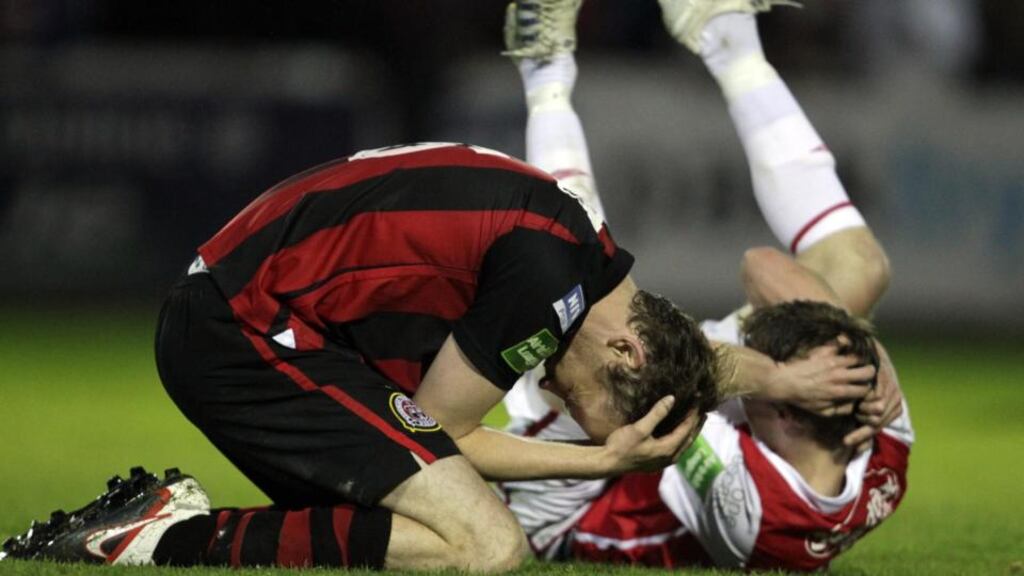What happens when two heads collide on a hurling, rugby, soccer or other sports pitch? The human skull is particularly resistant to shocks and hard to fracture, but how tough are its contents?
When tested in the lab, brain matter turns out not to be as stiff as you might think (see panel). This softness explains why we can be vulnerable to head impacts and traumas, whether due to accidents, bomb blasts or repetitive sport moves (think of the thousands of times footballers practise headers during their careers).
At the DCU centre for medical engineering research, Dr Jerry Murphy works on measuring the engineering characteristics of brain matter. "Surprisingly little is known about its most basic aspects, such as its stiffness, its resistance to tear or its response to shearing or twisting forces," he says. "By measuring these, we will be able to design better body protection in cars and better helmets in sports."
Helmet shortcomings
Currently most helmets only deal with head-on impact scenarios. They do not especially protect the area below the temporal bone on the base of the skull, which is thin and vulnerable to side impacts, nor can they protect from twisting motions, which can be very damaging to neurons – special cells that are the brain's pathways for information.
Dr Murphy has just joined a new delocalised laboratory, the International Brain Mechanics and Trauma Lab, which originated at the University of Oxford and is trying to test and model brain matter as if it were an engineering material. The ultimate goal of the lab is to uncover the relations between brain-tissue mechanics and brain function, diseases and trauma.
US military research
The US military drove early efforts in this research area. It was trying to understand what happens to the brain inside the skull when it is protected by body armour against projectiles but is still damaged by explosion blasts.
“It could be that the high-pressure wave generated by the explosion bounces longer inside the skull because of the hard shell helmets,” say Prof Antoine Jerusalem and Prof Alain Goriely, the co-founders of the lab at Oxford. “This is another example of a poorly understood mechanical effect that can lead to impairment. Clearly we need to pool resources and expertise together to tackle these questions at cell, tissue and medical levels.”
The international lab involves the partnership of more than 20 researchers from 12 main international centres, including DCU and NUI Galway, alongside MIT, Stanford and other major institutions.
Medical doctors will eventually be the main benefactors of the research, and the list of participants includes top specialists in neuropathology, neurosurgery, and neuro-oncology at Oxford's John Radcliffe Hospital.
Typically, neurosurgeons must operate under complicated constraints due to restricted access to the brain. Some neurological diseases are located in specific regions of the brain, where surgeons must operate with high accuracy, sometimes at the millimetre scale.
“In the hundred or so years that neurosurgery has become a discipline of its own, very little progress has been made in improving the survival rates of adult patients suffering from what we call ‘high-grade cancer tumours’,” says Dr Nick de Pennington, neurosurgery registrar at John Radcliffe Hospital. “It still stands at 12-18 months, max.”
He explains that to determine the contours of a tumour when operating, surgeons rely on experience and tactile clues, because tumours feel different physically from the surrounding tissue. Effectively they use a finger to probe the brain tissue, trying to feel where the tumour lies. It is an extremely crude tool, however, and surgeons would like something more precise.
“This is empirically based medicine, and I would like to see more physical and biological science entering into our decision-making process. This is why I am so hopeful about what the lab is trying to achieve, as the convergence of all those experts from different fields is definitely new and holds great promise for us.”
HEAD-TO-HEAD: MINIMISING RUGBY INJURY
Is brain matter stiffer or softer than jelly? Most people would guess the wrong answer.
When tested, brain tissue turns out to be 10-20 times less resistant to shearing forces than ordinary gelatin. Although encased in a very tough enclosure, the brain can still be shaken and stretched by pressure waves following an impact, such as those that occur accidentally on a rugby pitch. At a high enough level, the impact leads to concussion.
The mechanisms set in motion by a concussion event are not well understood. They might include high stress waves, swelling, altered biochemical signals and even damage at the neuron level.
Assessing the severity of a head injury can be difficult in the heat of a rugby game. To help with this task, both the Irish Rugby Football Union and the International Rugby Board have recently created and enforced new protocols intended to reduce the risk of a concussed player not leaving the pitch after an impact.
The pitch-side concussion assessment tool endorsed by the International Rugby Board was recently tested in a pilot study covering more than 700 matches over the last two years. Its results have just been published by the British Journal of Sport Medicine.
“We were pleased to see that the International Rugby Board tool is very good at identifying and removing players with concussions, which were confirmed later by a thorough clinical judgment,” says one of the co-authors, Prof Philippe Decq, a neurosurgeon at the Beaujon hospital in France.
“Although there have been some animal trials to find out what happens exactly in the brain during an injury, we do not have much information for the propagation of pressure waves in the human brain.”
Michel Destrade is professor of applied maths at NUI Galway and is at The Irish Times as a British Science Association/Science Foundation Ireland media fellow










